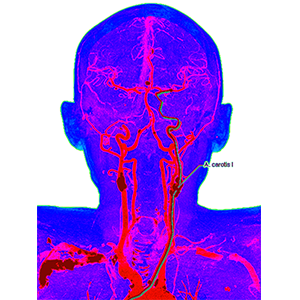Carotid Artery Stenosis is a term that refers to the narrowing of the carotid arteries –two large blood vessels that deliver oxygenated blood to the large, front part of the brain. When the carotid arteries are obstructed, you may be at an increased risk for a stroke, the 5th leading cause of death in the U.S.
Carotid artery stenosis (i.e. narrowing) is divided into asymptomatic (no symptoms) or symptomatic disease.
The vast majority of patients with carotid artery stenosis are asymptomatic and your primary care physician or vascular specialists often discover the blockage of the carotid artery during a routine yearly physical exam. Stenosis occurs when the carotid arteries in the neck become clogged with fatty deposits and cholesterol, also known as plaque. This condition is often discovered with the use of a carotid duplex ultrasound, CT-scan or MRI which determines the percentage narrowing of your carotid artery.
In the event of a symptomatic stenosis, patients may have symptoms of a mini-stroke (i.e. transient ischemic attack or TIA), such as temporary weakness on one side of the body, slurred speech, facial droop, confusion and clumsiness of the right or left upper or lower extremity (almost never does it occur on both sides at the same time).
Patients may also have transient blindness in one eye (Amaurosis Fugax), which is often described as a “curtain or shade coming down across the eye”. The above symptoms are often temporary and should prompt immediate medical attention.
The most devastating symptom of a carotid blockage is an acute stroke, where the above symptoms remain permanent or take an extended time to resolve. If patients experience these symptoms, they must seek emergency evaluation, as time to treatment is essential to the success of potential recovery.
Frequently Asked Questions (FAQs) Regarding Carotid Artery Stenosis
What are potential outcomes from a carotid artery blockage?
As discussed above, most patients remain asymptomatic and will never need an invasive intervention. These patients are carefully followed and monitored every 6-12 months with an ultrasound exam for the potential progression of their stenosis. There is a clinical correlation between the degrees (percentage) of carotid blockage and potential symptoms. Those patients with greater than 80% carotid stenosis are more likely to be symptomatic than those with a lower percentage of blockage. The overall risk of stroke in patients with greater than 60% stenosis is approximately 2% each year. The greatest overall risk for stroke occurs in those patients with a blockage of greater than 80%.
How is a blocked carotid artery treated?
A blockage of the carotid artery doesn’t necessarily mean that a patient will have a stroke or require intervention. Treatment can include medication (anti-platelet drug therapy such as aspirin or clopidogrel) and management of significant risk factors such as hypertension, high cholesterol, diabetes, obesity and tobacco use.
If it is determined that an intervention is required, the two main procedures which are performed are carotid endarterectomy (CEA) or carotid angioplasty and stenting (CAS).
In carotid endarterectomy, the blocked carotid artery is opened and the plaque is removed and the artery is closed. This is the most time-honored treatment modality and is still considered by many as the “gold standard” for the treatment. It is performed by a vascular specialist -- such as a board-certified vascular surgeon -- and has excellent short-term and long-term results with very low complication rates.
Carotid angioplasty and stenting (CAS) has recently become more popular and is performed using catheters, wires, balloons and stents, which are delivered through a small puncture in the groin or, more recently, through a small incision at the base of the neck. This modality is often used in those patients with carotid stenosis who may be at a higher risk for open surgery such as CEA.
When is medication a better treatment for carotid artery blockage than a procedure?
Asymptomatic patients with a carotid stenosis less than 70% probably should not be considered for surgery or intervention. These patients are best treated with anti-platelet medication and management of their cardiovascular risk factors.
Those patients with symptoms of carotid artery disease who have a stenosis in excess of 60% should be started on medication (i.e. aspirin and a statin) and considered for potential procedural intervention.
What percent blockage of a carotid artery is considered to be dangerous?
Patients with greater than 60% carotid narrowing who have symptoms of transient ischemic attacks (mini-strokes) or Amaurosis Fugax (temporary one-sided blindness) should seek medical attention. These patients are at risk for having a stroke without treatment.
Those patients with a carotid artery that has a greater than 70% narrowing might be considered for intervention if their life-expectancy is greater than 5 years and their overall co-morbidities are not prohibitive for intervention. This becomes particularly significant as the stenosis becomes greater than 80% as the risk of stroke is approximately 2-5% per year in these patients.
Contrary to intuition, those patients whose carotid artery is completely blocked (100% occluded) are actually in less danger than those whose artery might be 90-99% narrowed. This is simply because the obstruction to blood flow has already gotten as bad as it can get and the other arteries bringing blood to the brain have taken over to supply the area originally cared for by the blocked artery.
To determine if you are at risk for carotid artery stenosis and to understand how specific treatments may affect you, schedule a consultation with one of our board-certified vascular surgeons today.









.jpg?width=944&name=Castle-Connolly-Top-Doctors-Emblem-Large%20(4).jpg)